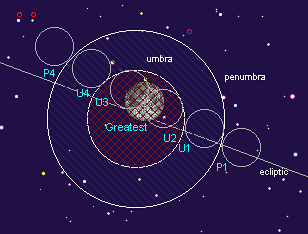|
- - text and links as of last publication - - October 28th, 2004 Moon Total Eclipse
Semi-durations:
This second and last 2004 total Moon eclipse is deeper in the umbra than the previous one. At greatest eclipse Moon southern limb is at 0.7' from shadow's center as northern limb is at 9.5' from shadow's edge. Moon brightness is expected undergoing large variations. Moon is transiting in umbra's northern part. For more details (local conditions, path) about the eclipse see Fred Espenak's Eclipse Home Page. About how a Moon eclipse works and observational techniques, see the tutorials "Moon Eclipses" and "Observing a Moon Eclipse" Observation Reports: Due to bad weather in France, the webmaster could not observe the eclipse. Other sources are showing that the eclipse might have been of a dark sort although the northern limb of the Moon remained lighter. This might be expected due to the configuration of the eclipse, the Moon transiting in the upper part of Earth's shadow. About the overall brightness of the eclipse, some sources are stating that the recent volcanic activity of Mt. St. Helens having been mostly steam with little ash, this was to be without effect on the eclipse Website Manager: G. Guichard, site 'Amateur Astronomy,' http://stars5.netfirms.com. Page Editor: G. Guichard. last edited: 12/28/2010. contact us at ggwebsites@outlook.com |
 2004 like 2003 is granting us with two total lunar eclipses. This one is the second and last. As the first total Moon eclipse was a Middle East one, this last one is a South American one. The whole continent will see the eclipse in its entirety. Mid- and eastern part of the USA, Western Africa, western Europe from Finland to Spain, are treated too with the entirety of the eclipse. East Asia, Australia, New Zealand are out of the show. From Eastern Europe to India, and in most Africa, eclipse is interrupted by moonset. Pacific coast of North America, Alaska and Hawai see the eclipse at moonrise. A total moon eclipse unfolds according to a 7 moments sequence
2004 like 2003 is granting us with two total lunar eclipses. This one is the second and last. As the first total Moon eclipse was a Middle East one, this last one is a South American one. The whole continent will see the eclipse in its entirety. Mid- and eastern part of the USA, Western Africa, western Europe from Finland to Spain, are treated too with the entirety of the eclipse. East Asia, Australia, New Zealand are out of the show. From Eastern Europe to India, and in most Africa, eclipse is interrupted by moonset. Pacific coast of North America, Alaska and Hawai see the eclipse at moonrise. A total moon eclipse unfolds according to a 7 moments sequence
